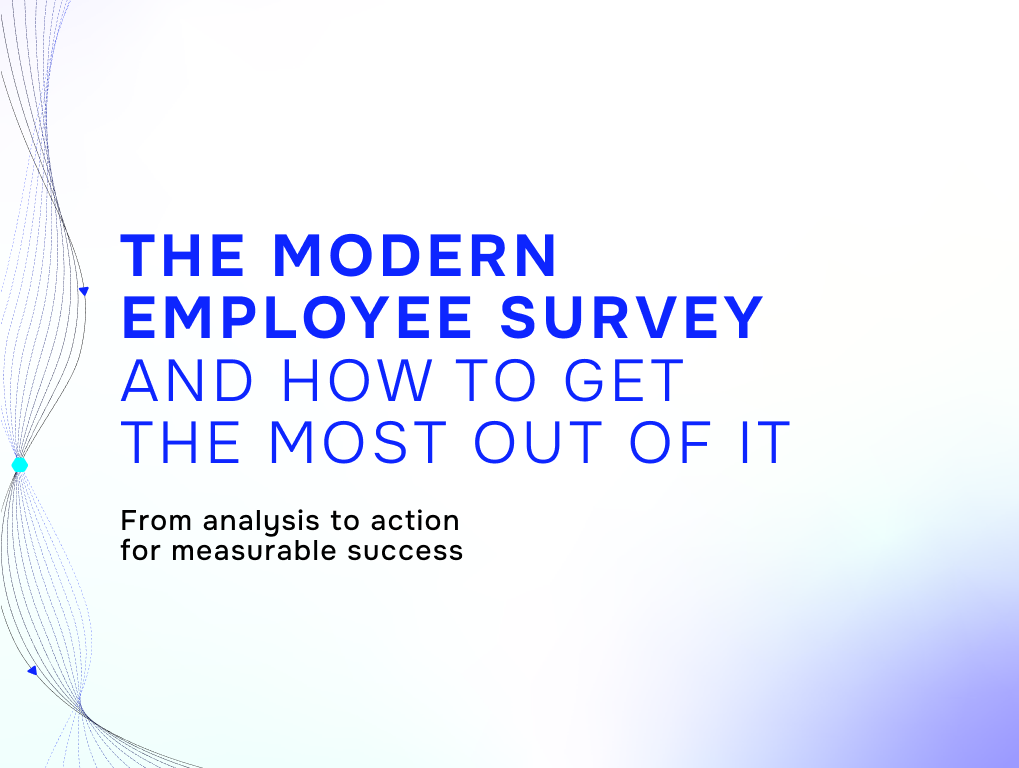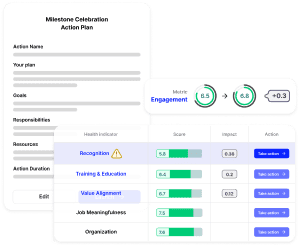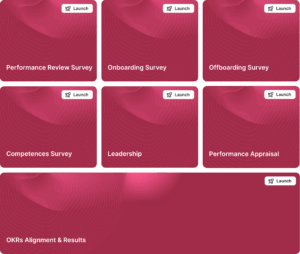As any HR or business leader knows, a company is only as strong as the people driving it forward each day. Business success relies on the employees who serve customers, keep operations running smoothly, and fuel growth. This is especially true for top performers who bring valuable industry experience and knowledge. Losing one of these key team members can cause significant setbacks for an organization—and unfortunately, it happens all too often.
In a recent study from Ciphr, over half of HR leaders stated that their biggest challenge for 2024 was retention.
Common reasons for employees to leave include compensation and benefits, a lack of career development opportunities, and issues with management or leadership. In fact, in the U.S., more than half of workers report leaving a job due to poor leadership, making it one of the biggest drivers of turnover.
While boosting compensation might seem like an obvious solution to address fluctuation, it may not be the most effective approach for your organization. In fact, many companies find that there are more impactful and budget-friendly strategies available. At atwork, for example, we’ve seen a strong correlation between retention and trust in management, which has statistically proven to be a more effective strategy than salary increases for keeping top talent.
According to research from Gallup, 75% of the reasons for voluntary turnover can be influenced by managers. By making a few adjustments to your company’s management practices, you can reduce turnover and build a healthier, more productive workforce.
Here, we’re exploring three key strategies for HR leaders and managers to try today.
Communicate clear goals and expectations
Clarity is essential for ensuring that employees feel committed to their roles. When people know exactly what’s expected of them, they’re more likely to be engaged and motivated long-term. However, when expectations are unclear, it can lead to frustration, confusion, and ultimately, a desire to leave.
Here’s an example: Andrea, a front-line hotel worker, was hired as a “guest services associate.” She quickly became vital to the hotel’s overall operations. However, her role was never clearly defined, and she found herself juggling a variety of different responsibilities, from guest check-ins to housekeeping and even admin tasks. Over time, Andrea became confused and frustrated, unsure of how to prioritize her work or if she was meeting expectations—and her manager was too busy to guide her. This lack of clarity eventually led her to consider another job with more defined objectives and goals.
This is a common scenario, particularly in fast-paced industries like hospitality. Fortunately, it can be avoided with a few tweaks to management practices.
HR leaders and managers should ensure that all employees have clarity around:
- Job responsibilities
- Impact
- Expectations
To start, ensure that every employee has a clear job description. HR should work with hiring managers to define job descriptions and responsibilities before an employee is onboarded, and these descriptions should be reviewed and updated at regular intervals.
According to internal research from atwork, role clarity is highly correlated with factors like “job meaningfulness” (β = 0.372) which in turn can have a major impact on retention. When employees are clear in their responsibilities, they are more likely to feel like they are contributing to something greater than themselves—motivating them to stay with the company long-term.
Next, consider how each role helps drive the company’s mission. Every employee’s contributions are essential, and it’s important that they understand the impact their work has on the organization. Managers need to clearly communicate this to their team members and make a point of celebrating their wins.
Finally, managers should provide employees with clear expectations on an ongoing basis. This means regularly checking in, setting measurable goals, and adjusting responsibilities as needed. When there is a high sense of management trust within an organization, atwork finds increased rates of “organizational commitment” (β = 0.073) and “intention to stay” (β = 0.223) among employees.
As an HR leader, consider implementing training and development programs for managers to help them enhance their communication skills.
Prioritize employee development plans
One of the most common reasons why employees leave their roles is a lack of opportunities for growth. This is particularly true for top performers.
Here’s an example: Scott, a marketing manager, was hired as an individual contributor. During interviews and onboarding, he shared his desire to become a manager within the company once there was a clear business need. But as time passed, the opportunity never arose. The company grew, but external hires were brought in to fill leadership roles. When Scott asked his manager and skip-level manager about opportunities for growth, neither was able to provide a clear answer—despite his performance exceeding expectations. Feeling pigeonholed, he decided to leave the company and take a Head of Growth position elsewhere. As a result, the company lost momentum on crucial marketing initiatives and fell short of achieving its quarterly revenue goals.
This scenario is all too common. Top talent thrives on growth—if they don’t see a clear path forward, they’ll likely seek opportunities elsewhere. While hiring great talent is important, managers need the proper training and leadership skills to keep employees motivated and engaged over the long term.
To start, managers and HR leaders should work together on defining career paths for each role. This should be documented and shared with employees during the hiring process and onboarding.
Managers should also regularly bring up the topic of career development in one-on-one meetings and performance reviews. This shows employees that their growth is a priority and helps managers get a sense of how satisfied they are in their current role and where they see themselves in the future.
Additionally, managers should be clear about the timelines and requirements for promotions. If an employee expresses an interest in advancing, be upfront about what they need to achieve and how long it might take to reach the next level (you can also refer to the career path for their role). If a promotion isn’t immediately available, help them understand what they can do to prepare. This kind of honest communication builds trust and prevents employees from feeling overlooked or undervalued.
HR leaders can also play a key role in supporting employees by creating opportunities for learning and development across the organization.
Build a collaborative work environment
Satisfaction at work often comes down to the rapport and sense of belonging that employees feel within their teams. When people feel comfortable sharing ideas and working with their peers to achieve common goals, they are more likely to stick around. But when employees feel siloed, it can lead to frustration and burnout.
Here’s an example: Laura, a financial analyst, was excited to join her firm because of its strong company culture and reputation for having a supportive team. However, once she started, she realized that her department had little interaction with other teams, and she was frequently assigned projects that required her to work independently. The lack of collaboration left her feeling isolated, overwhelmed, and unmotivated. It wasn’t long before she decided to leave for a different job. Given her highly specialized skillset, the company struggled for months to find a replacement.
To avoid situations like these, managers should strive to create a culture of collaboration within their teams. This can be achieved by encouraging regular communication (such as hosting team-wide meetings or activities), assigning groups to tackle specific projects rather than having employees work alone, and ensuring that team members have opportunities to interact and share ideas, both within and outside of their departments.
Internal research from atwork shows that factors like “peer trust,” “social support,” and “team atmosphere” are all highly correlated and can influence feelings of employee inclusion safety (β = 0.066, β = 0.201, and β = 0.231, respectively), which is crucial for creating the type of environment that employees want to work in long-term.
HR leaders can help by creating initiatives that promote teamwork and communication across the company. This could include team-building activities or learning and development programs that bring together employees from different departments.
Additionally, HR should provide training for managers on how to build greater unity and cohesion within their teams, helping ensure that everyone feels connected and engaged.
Boosting retention with atwork
If you’re struggling with fluctuation in your business, it’s important to recognize that there’s no one-size-fits-all solution. While these HR strategies can help boost retention, their effectiveness will depend on your organization’s unique needs. That’s where atwork comes in.
Talent can leave for various reasons—from a lack of career development opportunities to work-life balance issues, leadership engagement, values misalignment, compensation, and many other influencing factors.
Atwork takes a science-backed approach to help HR teams identify retention risks and growth opportunities. From improving employee surveys to analyzing key HR metrics like eNPS and engagement alongside business KPIs, atwork’s AI-powered tools transform insights into personalized action plans, tailored to your organization’s needs.
Want to find out more? Request a demo of atwork today.
You may also like

Engaged to Care: Transforming Swiss Hospital Workforces through AI and Strategy
Swiss hospitals are facing rising burnout, absenteeism, and disengagement among staff — but AI-powered tools could be the key to turning things around. This study, conducted by students at Lucerne University of Applied Sciences and Arts in collaboration with atwork, explores how strategic HR technology can help transform employee engagement in the healthcare sector.

Optimizing Employee Engagement through Modern Surveys
Equip yourself with the knowledge and tools to drive organizational success and create a thriving workplace culture.

How do you get meaningful results from employee surveys?
We all know what it’s like: you get surveys in your e-mail inbox, requesting you to evaluate a service or your own employer. The questions and answers you can select are often the same. So, most people just sign off. A low response rate is not only irritating. If the rate is too low, the […]





 Guides
Guides  Studies
Studies